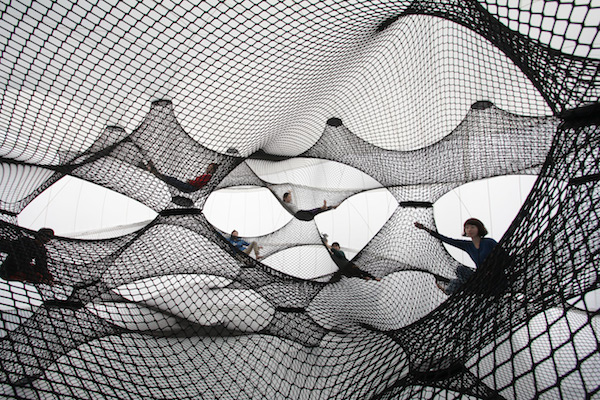Design
Numen/For Use: Design Collective
Industrial designers Sven Jonke, Christoph Katzler and Nikola Radeljković joined forces in 1998 under the name Numen For Use, and the following year, they established the art collective Numen to realize spatial design, scenography, and conceptual art projects.
A truly international collective – Nikola lives and works in Zagreb, Christoph in Vienna, and Sven in Berlin – the three have collaborated on projects all over the world, from the redesign of the waterfront Riva in Split, Croatia, to creating atmospheric installations in cities such as Tokyo, Melbourne, and Stockholm. Here, Nikola discusses the collective’s approach to design, their use of unexpected materials, and their current projects.
You started as industrial designers – can you tell us about your transition from industrial design into spatial design?
We were always interested in space. We considered design as a part of a broader issue, [that of the] man-made environment. So, we explored topics of architecture and its history, and were struck by the strong concept and unity of the early Modernists. At both of our schools (Faculty of Design in Zagreb and School of Applied Arts in Vienna), the Post-modernist relativization was flourishing, so our conviction to the continuation of the humanistic aspect of Modernism was a kind of rebellion against the established state of mind. When we got the [chance to design a set], we adapted the conceptual approach, where the difference between a chair and a house is just a question of technology and size. Of course we had to learn a lot during our first projects, but isn’t that the beauty of creative work, learning with every project?
What are your priorities or goals when working on a project?
First we try to understand the project in a wider spectrum. What is behind it, who are we making it for, what are the aspects or impacts of the project that are beyond the perception of the investor? Then we search for a concept… where we [transform] problems into opportunities. Where a solution uses the least material and effort, for maximum effect. This is where our design education comes out. We develop the project thinking of budget, technology and the “user” or viewer.
How do you choose the materials you work with, for example tape? Which comes first: the material or the concept?
Probably a little bit of both! When we came up with tape, we were developing several conceptual set designs and experimented with elastic fabrics, and various types of lines and ropes. When we tried making a model with tape we recognized an unintentional development of complex organic forms, and then we started playing.
The tape installations are unexpectedly beautiful. How long does it take to create an installation? How much tape do you use? And what happens to it all in the end?
I don’t know if I would call it beautiful. It is wondrous, no doubt, but there is a certain feeling of loss of control, an appearance of something not done by human beings…The installation is, in most cases, produced within 4-5 days, but the preparation time spans to several months of planning, model testing, resolving management, and legal issues, and so on. It consists of more or less 100 to 150 kg of tape, or to put it more perceptibly, some 500 rolls of common Scotch tape. The installations have different destinies after disassembly. Some are cut into small pieces and given to visitors as souvenirs, and some are cut into bigger pieces and re-used as sunshades, as it happened in Australia. But, unfortunately, most of it ends up in the garbage.
You are all based in different cities. Are any of them particularly conducive to your creative work?
There are, as always, pros and cons for this or that place and, I guess, each of us chose the place that suits him the best. Croatia is still in transition and design is not as common and as business oriented as in Austria and Germany, so all that we do is kind of a pioneer job. The situation is developing rapidly and the scene is constantly evolving. For me it is inspiring to be here and support the development of design.
Are you currently working on any projects that you can tell us about?
We are currently developing a self-initiated project based on the technology of the production of big, geometric, blown-up objects usually used for advertising. It is also a walk-in installation, but the disintegration of the perception of space works on a totally different level, as in the case of Net. Something like Numen Light that you can walk in and climb. We are [also] currently developing furniture for Donaukanal in Vienna, and [are looking] forward to its finalization. I really wish we [could] work on something like the High Line [NYC] in the future.
Interview by Elaine Ritchel (@elaineritchel)
Image source: Numen / For Use












